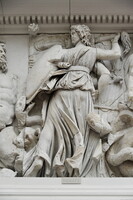| dc.coverage.spatial | Site: Pergamon Museum (Berlin, Berlin (state), Germany) | en_US |
| dc.coverage.spatial | Site: Pergamon Museum (Berlin, Berlin (state), Germany) | en_US |
| dc.coverage.temporal | ca.170 BCE-159 BCE (creation); excavated 1878-1886 (other) | en_US |
| dc.creator | unknown (Greek (ancient)) | en_US |
| dc.date | -170--159 | en_US |
| dc.date.accessioned | 2013-10-17T20:32:31Z | |
| dc.date.available | 2013-10-17T20:32:31Z | |
| dc.date.issued | -170--159 | en_US |
| dc.identifier | 238773 | en_US |
| dc.identifier.other | archrefid: 2537 | en_US |
| dc.identifier.uri | http://hdl.handle.net/1721.3/146542 | |
| dc.description | Gigantomachy, East frieze; Hecate fights against Klytios (left); The sculptures produced at Pergamon during the period of Attalid rule (282-133 BCE) are among the most important examples of Hellenistic court art. Many original works have been uncovered during more than a century of excavations at Pergamon itself. The first fragment of the Great Frieze of the Great Altar at Pergamon was excavated in 1871 by Carl Humann (1836-1896), which led to the discovery of the biggest relief cycle known from antiquity. Large parts of this frieze, which has over life-size figures and is almost 120 m long and 2.3 m high, now constitute the principal exhibit of the Pergamonmuseum in Berlin; a few fragments are in England. In Berlin, Italian restorers reassembled the panels comprising the frieze from the thousands of fragments that had been recovered. The frieze in high relief shows the battle between the Giants and the Olympian gods known as the Gigantomachy. There is a second, smaller (1.58 meters high) and less well-preserved frieze on the inner court walls which surround the actual fire altar on the upper level of the structure at the top of the stairs. It depicts events from the life of Telephus, legendary founder of the city of Pergamon and son of the hero Heracles. The exact date, dedication, builder and purpose of the altar is still debated. The work was restored in 2004. Source: Grove Art Online; http://www.oxfordartonline.com/ (accessed 7/23/2012) | en_US |
| dc.format.medium | marble | en_US |
| dc.rights | © Scott Gilchrist, Archivision, Inc. | en_US |
| dc.subject | allegory | en_US |
| dc.subject | architecture | en_US |
| dc.subject | cycles or series | en_US |
| dc.subject | deities | en_US |
| dc.subject | mythology (Classical) | en_US |
| dc.subject | archaeology | en_US |
| dc.subject | Museology | en_US |
| dc.subject | Greek Empire | en_US |
| dc.subject | Asia Minor | en_US |
| dc.subject | Hellenistic | en_US |
| dc.subject | Pergamene (sculpture style) | en_US |
| dc.title | Great Altar at Pergamon [reconstruction] | en_US |
| dc.type | image | en_US |
| dc.rights.access | Licensed for educational and research use by the MIT community only | en_US |
| dc.identifier.vendorcode | 7A3-G-PM-PA-B6 | en_US |
| vra.culturalContext | Greek (ancient) | en_US |
| vra.technique | construction (assembling), carving (processes) | en_US |
| vra.worktype | stair | en_US |
| vra.worktype | frieze (entablature component) | en_US |
| vra.worktype | shrine (structure) | en_US |
| vra.worktype | relief (sculpture) | en_US |
| dc.contributor.display | unknown (Greek (ancient)) | en_US |



